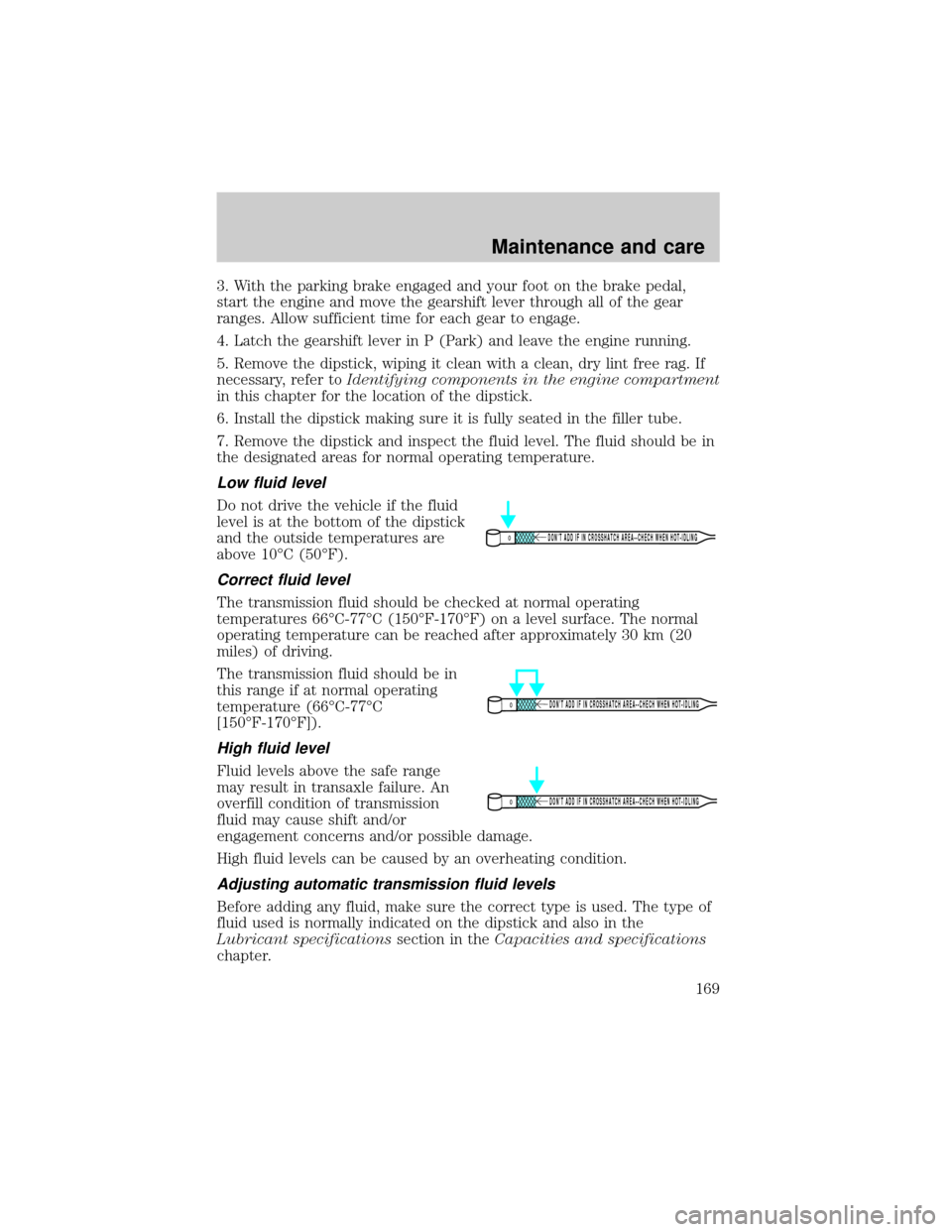check engine Mercury Sable 2001 s Owner's Guide
[x] Cancel search | Manufacturer: MERCURY, Model Year: 2001, Model line: Sable, Model: Mercury Sable 2001Pages: 240, PDF Size: 2.22 MB
Page 168 of 240

5. If the fluid is low, add fluid in small amounts, continuously checking
the level until it reaches the FULL HOT range. Be sure to put the
dipstick back in the reservoir.
3.0L DOHC V6 Duratec engine
4. Check the fluid level in the
reservoir. It should be between the
MIN and MAX lines. Do not add
fluid if the level is within this range.
5. If the fluid is low, add fluid in small amounts, continuously checking
the level until it reaches the range between the MIN and MAX lines. Be
sure to put the cap back on the reservoir.
TRANSMISSION FLUID
Checking automatic transmission fluid
Refer to your scheduled maintenance guide for scheduled intervals for
fluid checks and changes. Your transaxle does not consume fluid.
However, the fluid level should be checked if the transaxle is not working
properly, i.e., if the transaxle slips or shifts slowly or if you notice some
sign of fluid leakage.
Automatic transmission fluid expands when warmed. To obtain an
accurate fluid check, drive the vehicle until it is warmed up
(approximately 30 km [20 miles]). If your vehicle has been
operated for an extended period at high speeds, in city traffic
during hot weather or pulling a trailer, the vehicle should be
turned off for about 30 minutes to allow fluid to cool before
checking.
1. Drive the vehicle 30 km (20 miles) or until it reaches normal operating
temperature.
2. Park the vehicle on a level surface and engage the parking brake.
MINMAX
Maintenance and care
168
Page 169 of 240

3. With the parking brake engaged and your foot on the brake pedal,
start the engine and move the gearshift lever through all of the gear
ranges. Allow sufficient time for each gear to engage.
4. Latch the gearshift lever in P (Park) and leave the engine running.
5. Remove the dipstick, wiping it clean with a clean, dry lint free rag. If
necessary, refer toIdentifying components in the engine compartment
in this chapter for the location of the dipstick.
6. Install the dipstick making sure it is fully seated in the filler tube.
7. Remove the dipstick and inspect the fluid level. The fluid should be in
the designated areas for normal operating temperature.
Low fluid level
Do not drive the vehicle if the fluid
level is at the bottom of the dipstick
and the outside temperatures are
above 10ÉC (50ÉF).
Correct fluid level
The transmission fluid should be checked at normal operating
temperatures 66ÉC-77ÉC (150ÉF-170ÉF) on a level surface. The normal
operating temperature can be reached after approximately 30 km (20
miles) of driving.
The transmission fluid should be in
this range if at normal operating
temperature (66ÉC-77ÉC
[150ÉF-170ÉF]).
High fluid level
Fluid levels above the safe range
may result in transaxle failure. An
overfill condition of transmission
fluid may cause shift and/or
engagement concerns and/or possible damage.
High fluid levels can be caused by an overheating condition.
Adjusting automatic transmission fluid levels
Before adding any fluid, make sure the correct type is used. The type of
fluid used is normally indicated on the dipstick and also in the
Lubricant specificationssection in theCapacities and specifications
chapter.
DON’T ADD IF IN CROSSHATCH AREA--CHECH WHEN HOT-IDLING
DON’T ADD IF IN CROSSHATCH AREA--CHECH WHEN HOT-IDLING
DON’T ADD IF IN CROSSHATCH AREA--CHECH WHEN HOT-IDLING
Maintenance and care
169
Page 177 of 240

2. Put the gearshift in P (Park), turn off all accessories and start the
engine.
3. Run the engine until it reaches normal operating temperature.
4. Allow the engine to idle for at least one minute.
5. Turn the A/C on and allow the engine to idle for at least one minute.
6. With your foot on the brake pedal and with the A/C on, put the
vehicle in D (Drive) and allow the engine to idle for at least one minute.
7. Drive the vehicle to complete the relearning process.
²The vehicle may need to be driven 16 km (10 miles) or more to
relearn the idle and fuel trim strategy.
²If you do not allow the engine to relearn its idle trim, the idle
quality of your vehicle may be adversely affected until the idle
trim is eventually relearned.
If the battery has been disconnected or a new battery has been installed,
the clock must be reset once the battery is reconnected.
²Always dispose of automotive
batteries in a responsible manner.
Follow your local authorized
standards for disposal. Call your
local authorized recycling center
to find out more about recycling
automotive batteries.
WINDSHIELD WIPER BLADES
Check the wiper blades at least twice a year or when they seem less
effective. Substances such as tree sap and some hot wax treatments used
by commercial car washes reduce the effectiveness of wiper blades.
Checking the wiper blades
If the wiper blades do not wipe properly, clean both the windshield and
wiper blades using undiluted windshield wiper solution or a mild
detergent. Rinse thoroughly with clean water. To avoid damaging the
blades, do not use fuel, kerosene, paint thinner or other solvents.
LEAD
RETURN
RECYCLE
Maintenance and care
177
Page 184 of 240

When refueling always shut the engine off and never allow
sparks or open flames near the filler neck. Never smoke while
refueling. Fuel vapor is extremely hazardous under certain conditions.
Care should be taken to avoid inhaling excess fumes.
The flow of fuel through a fuel pump nozzle can produce static
electricity, which can cause a fire if fuel is pumped into an
ungrounded fuel container.
Use the following guidelines to avoid static build-up when filling an
ungrounded fuel container:
²Place approved fuel container on the ground.
²DO NOT fill a fuel container while it is in the vehicle.
²Keep the fuel pump nozzle in contact with the fuel container while
filling.
²DO NOT use a device that would hold the fuel pump handle in the fill
position.
Fuel Filler Cap
Your fuel tank filler cap has an indexed design with a 1/8 turn on/off
feature.
When fueling your vehicle:
1. Turn the engine off.
2.
Carefully turn the filler cap counterclockwise 1/8 of a turn until it stops.
3. Pull to remove the cap from the fuel filler pipe.
4. To install the cap, align the tabs on the cap with the notches on the
filler pipe.
5. Turn the filler cap clockwise 1/8 of a turn until it stops.
If the ªCheck Fuel Capº
indicator comes on or if ªService Engine
Soon/Check Engineº indicator comes on and stays on when you start the
engine, the fuel filler cap may not be properly installed. Turn off the
engine, remove the fuel filler cap, align the cap properly and reinstall it.
If you must replace the fuel filler cap, replace it with a fuel filler
cap that is designed for your vehicle. The customer warranty may
be void for any damage to the fuel tank or fuel system if the
correct genuine Ford or Motorcraft fuel filler cap is not used.
Maintenance and care
184
Page 189 of 240
![Mercury Sable 2001 s Owners Guide ²Sudden or hard accelerations may reduce fuel economy.
²Slow down gradually.
²Driving at reasonable speeds (traveling at 88 km/h [55 mph] uses 15%
less fuel than traveling at 105 km/h [65 mph]).
² Mercury Sable 2001 s Owners Guide ²Sudden or hard accelerations may reduce fuel economy.
²Slow down gradually.
²Driving at reasonable speeds (traveling at 88 km/h [55 mph] uses 15%
less fuel than traveling at 105 km/h [65 mph]).
²](/img/33/11160/w960_11160-188.png)
²Sudden or hard accelerations may reduce fuel economy.
²Slow down gradually.
²Driving at reasonable speeds (traveling at 88 km/h [55 mph] uses 15%
less fuel than traveling at 105 km/h [65 mph]).
²Revving the engine before turning it off may reduce fuel economy.
²Using the air conditioner or defroster may reduce fuel economy.
²You may want to turn off the speed control in hilly terrain if
unnecessary shifting between third and fourth gear occurs.
Unnecessary shifting of this type could result in reduced fuel
economy.
²Warming up a vehicle on cold mornings is not required and may
reduce fuel economy.
²Resting your foot on the brake pedal while driving may reduce fuel
economy.
²Combine errands and minimize stop-and-go driving.
Maintenance
²Keep tires properly inflated and use only recommended size.
²Operating a vehicle with the wheels out of alignment will reduce fuel
economy.
²Use recommended engine oil. Refer toLubricant Specifications.
²Perform all regularly scheduled maintenance items. Follow the
recommended maintenance schedule and owner maintenance checks
found in your vehicle scheduled maintenance guide.
Conditions
²Heavily loading a vehicle or towing a trailer may reduce fuel economy
at any speed.
²Carrying unnecessary weight may reduce fuel economy (approximately
0.4 km/L [1 mpg] is lost for every 180 kg [400 lb] of weight carried).
²Adding certain accessories to your vehicle (for example bug
deflectors, rollbars/light bars, running boards, ski/luggage racks) may
reduce fuel economy.
²Using fuel blended with alcohol may lower fuel economy.
²Fuel economy may decrease with lower temperatures during the first
12±16 km (8±10 miles) of driving.
Maintenance and care
189
Page 192 of 240

Allow the vehicle to sit for at least eight hours without starting the
engine. Then, start the engine and complete the above driving cycle. The
engine must warm up to its normal operating temperature. Once started,
do not turn off the engine until the above driving cycle is complete.
BULBS
Replacing exterior bulbs
Check the operation of the following lamps frequently:
²Headlamps
²Tail lamps
²Brakelamps
²High-mount brakelamp
²Turn signals
²Backup lamps
²License plate lamp
Do not remove lamp bulbs unless they will be replaced immediately. If a
bulb is removed for an extended period of time, contaminants may enter
the lamp housings and affect performance.
Maintenance and care
192
Page 231 of 240

A
Accessory delay ..........................57
Air bag supplemental
restraint system ............96±97, 101
and child safety seats ..............99
description ........................97, 101
disposal ....................................103
driver air bag ............97, 100, 102
indicator light .....................13, 99
operation ...................97, 100, 102
passenger air bag .....97, 100, 102
side air bag ..............................101
Air cleaner filter .......................210
Air conditioning ..........................19
automatic temperature
control system ..........................23
Air filter, cabin ..........................170
Antifreeze
(see Engine coolant) ................162
Anti-lock brake system
(see Brakes) ......................118±119
Anti-theft system ........................67
arming the system ....................67
disarming a triggered system ..68
warning light .............................11
Audio system (see Radio) .........29
Automatic transaxle .................123
driving with .............................125
fluid, adding ............................168
fluid, checking ........................168
fluid, refill capacities ..............211
fluid, specification ..................213
Auxiliary power point .................29
Axle
lubricant specifications ..........212B
Battery .......................................175
acid, treating emergencies .....175
charging system
warning light .............................13
jumping a disabled battery ....147
maintenance-free ....................175
replacement, specifications ...210
servicing ..................................175
Belt minder .................................92
Brakes ........................................118
anti-lock ...........................118±119
anti-lock brake system
(ABS) warning light .........11, 119
brake warning light ..................12
fluid, checking and adding ....160
fluid, refill capacities ..............211
fluid, specifications .........212±213
lubricant specifications ..212±213
parking ....................................120
pedals (see Power
adjustable foot pedals) ............46
shift interlock ..........................123
Break-in period .............................3
C
Capacities for refilling fluids ....211
Cargo area shade ........................62
Cargo cover .................................61
Cargo net .....................................61
CD changer .................................42
Cellular telephone
Wireless Interface Module .......54
Certification Label ....................215
Child safety restraints ..............104
child safety belts ....................104
Index
231
Page 232 of 240

Child safety seats ......................105
attaching with tether straps ..109
in front seat ............................106
in rear seat ......................106, 109
LATCH .....................................111
Cleaning your vehicle ...............204
engine compartment ..............207
exterior ....................................205
exterior lamps .........................206
instrument cluster lens ..........208
instrument panel ....................208
interior .............................208±209
mirrors .....................................206
plastic parts ............................206
safety belts ..............................209
washing ....................................204
waxing .....................................205
wheels ......................................206
windows ..................................209
wiper blades ............................206
woodtone trim ........................209
Climate control (see Air
conditioning or Heating) ............19
Clock ......................................35, 41
Console ........................................59
Controls
power seat .................................78
Coolant
checking and adding ..............162
refill capacities ................165, 211
specifications ..................212±213
Cruise control
(see Speed control) ....................47
Customer Assistance ................135
Ford accessories
for your vehicle ......................225
Ford Extended
Service Plan ............................217Getting assistance outside
the U.S. and Canada ..............224
Getting roadside assistance ...135
Getting the
service you need ....................217
Ordering additional
owner's literature ...................228
The Dispute
Settlement Board ...................220
Utilizing the Mediation/
Arbitration Program ...............223
D
Daytime running lamps
(see Lamps) ................................17
Defrost
rear window ..............................19
Dipstick
automatic
transmission fluid ...................168
engine oil .................................157
Doors
door ajar warning .......................9
lubricant specifications ..........212
Driving under special
conditions
through water .........................129
E
Emergencies, roadside
jump-starting ..........................147
Emission control system ..........190
Engine ........................................213
check engine/
service engine soon light ...........9
cleaning ...................................207
coolant .....................................162
Index
232
Page 233 of 240

idle speed control ...................175
lubrication
specifications ..................212±213
refill capacities ........................211
service points ..................155±156
starting after a collision .........136
Engine block heater .................116
Engine oil ..................................157
checking and adding ..............157
dipstick ....................................157
filter, specifications ........159, 210
recommendations ...................159
refill capacities ........................211
specifications ..................212±213
Exhaust fumes ..........................116
F
Floor mats ...................................59
Fluid capacities .........................211
Foglamps .....................................18
Fuel ............................................182
calculating fuel economy .......187
cap .......................................9, 184
capacity ...................................211
choosing the right fuel ...........185
comparisons with EPA fuel
economy estimates .................190
detergent in fuel .....................186
filling your vehicle
with fuel ..................182, 184, 187
filter, specifications ........186, 210
fuel pump shut-off switch .....136
gauge .........................................16
improving fuel economy ........187
low fuel warning light ..............11
octane rating ...................185, 213
quality ......................................185
running out of fuel .................186safety information relating to
automotive fuels .....................182
Fuses ..................................138±139
G
Gas cap (see Fuel cap) ........9, 184
Gas mileage
(see Fuel economy) .................187
Gauges .........................................14
engine coolant
temperature gauge ...................15
fuel gauge ..................................16
odometer ...................................15
speedometer .............................14
tachometer ................................14
trip odometer ............................15
GAWR
(Gross Axle Weight Rating) .....128
definition .................................128
driving with a heavy load ......128
location ....................................128
GVWR (Gross
Vehicle Weight Rating) .............128
calculating ...............................128
definition .................................128
driving with a heavy load ......128
location ....................................128
H
Hazard flashers .........................136
Head restraints ...........................77
Headlamps ...................................17
aiming ..............................202±203
autolamp system .......................18
bulb specifications ..................201
daytime running lights .............17
flash to pass ..............................17
Index
233
Page 234 of 240

high beam .............................8, 17
replacing bulbs .......................193
turning on and off ....................17
warning chime ..........................13
Heating ........................................19
heating and
air conditioning system ............19
Hood ..........................................154
I
Ignition .................................47, 213
Infant seats
(see Safety seats) .....................105
Inspection/maintenance
(I/M) testing ..............................191
Instrument panel
cleaning ...................................208
cluster ..................................8, 208
lighting up
panel and interior .....................18
location of components ..............8
J
Jack ............................................143
positioning ...............................143
storage .....................................143
Jump-starting your vehicle ......147
K
Keyless entry system .................69
autolock .....................................71
keypad .......................................69
locking and unlocking doors ....71
programming entry code .........70
Keys .......................................73, 75
key in ignition chime ...............13positions of the ignition ...........47
L
Lamps
autolamp system .......................18
bulb replacement
specifications chart ................201
cargo lamps ...............................18
daytime running light ...............17
fog lamps ...................................18
headlamps .................................17
headlamps, flash to pass ..........17
instrument panel, dimming .....18
interior lamps .............52±53, 201
replacing
bulbs ........192±193, 195±197, 200
Lane change indicator
(see Turn signal) ........................50
Liftgate ..................................60, 64
Lights, warning and indicator ......8
air bag ........................................13
anti-lock brakes (ABS) ....11, 119
anti-theft ...................................11
brake ..........................................12
charging system ........................13
check coolant ............................12
cruise indicator .........................12
door ajar ......................................9
fuel cap light ...............................9
high beam ...................................8
low coolant ................................11
low fuel ......................................11
oil pressure ...............................12
safety belt ...................................9
service engine soon ....................9
speed control ............................50
traction control active ................8
turn signal indicator ...................8
Load limits .................................128
Index
234